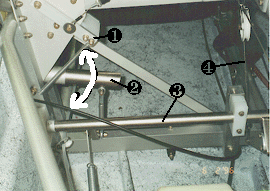![]()

Unlike the Buccaneers, which use a cloth covering from the main hull up to the wing, the Aventuras use a formed Fiberglas (or in this case, Kevlar) "hardtop." Here is the first fitting.
![]()

The Aventuras use an ingenious gear retract system. This view is looking forward from behind the main bulkhead on the left side. The gear is retracted.
1: Gear Lock.
2: Gear Leg.
3: Torque Tube.
4: Tailwheel Retract Cable.
Here's how it works:
The retract lever in the cockpit has a bicycle-brake type handle on it. When it's squeezed the Gear Lock (1) is pulled up and away from the Gear Leg (2). The retract lever in the cockpit is then pulled back and rotated flat into its locked position against the center cockpit tube between the seats. This causes the Torque Tube (3) to rotate, and via the link, to pull the inside end of the Gear Leg down - which causes the gear leg outside the hull to go up. While all this is going on, the Tailwheel Retract Cable (4) is being pulled, which unlocks the tailwheel mechanism and pulls it forward into a pocket inside the hull.
To extend the gear, the retract handle in the cockpit is pulled up out of its locked position, forward, and down. The torque tube rotates, allowing the gear leg to come up inside and snap under the gear lock. Meanwhile the pressure is released on the tailwheel cable which lets it swing down and back, assisted with a bungee, until it locks into place.
Synchronization:
Here's the tricky part. When retracting the gear, the retract lever in the cockpit has to lock into position, the main wheels have to be up as far as possible, and the tailwheel mechanism has to be pulled tight against the main boom tube - all at the same time.
When extending the gear, both main gear legs have to snap under the gear locks at exactly the same time; otherwise you may land with one of the legs unlocked. There also has to be enough slack in the tailwheel retract cable to allow the tailwheel mechanism to snap all the way into place.
What happens if you don't have everything synchronized? You've extended the gear, but one of the gear legs isn't locked. At that point, the only thing supporting that side of the plane is the link from the gear leg to the torque tube. This is built with a sacrificial threaded steel rod, which will break. After skidding to a stop (which won't hurt anything but your pride - assuming you're on a grass strip), you pick up that side of the plane, the gear rotates down and locks into place, and you fly home. When you get there, you replace the threaded rod and you're back in business. Neat.
By the way, checking the gear locks is part of my pre-landing procedure.
Check out a story about why the system needs to be set up correctly...